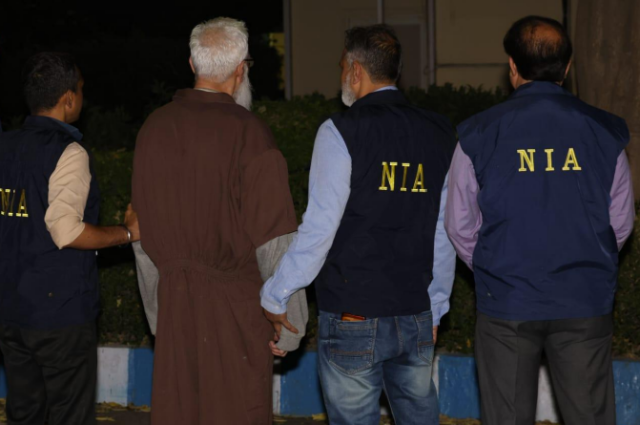After years of relentless effort, India has finally brought Tahawwur Hussain Rana, a key player in the devastating 26/11 Mumbai terror attacks to justice. Rana, a 64-year-old Canadian citizen of Pakistani origin, was successfully extradited from the United States and arrived in Delhi on 10th April. This marks a significant step in India's long fight for justice for the victims of the 2008 attacks.
The Process of Sending Criminals Across Borders: Understanding Extradition
Imagine a situation where someone accused or found guilty of a serious crime flees to another country. How does the country where the crime occurred get that person back to face justice? This is where "extradition" comes in. Extradition is basically the official handing over of a person from one nation to another. It's like a formal transfer of custody, where the country receiving the person now has the legal right to deal with them. This transfer happens when the receiving country wants to prosecute someone for a crime they're accused of or to make them serve a sentence for a crime they've already been found guilty of. Importantly, the act they committed must be considered a crime in both the country sending them and the country receiving them.
A country can ask another to send back a person they believe committed a crime. This request can happen at various stages which can be during an investigation, while the person is on trial, or after they've been convicted.
India's Rules for Bringing Back Fugitives
India has a set of rules called the Extradition Act, of 1962, which governs how it brings back people who have fled justice. These people are called "fugitive criminals." Essentially, a fugitive criminal is someone accused or convicted of a crime in another country and that crime falls under the rules of extradition.
To make this process smoother, India has agreements or "extradition treaties," with certain countries, like the UK, the USA, and Bangladesh. These treaties are formal understandings that outline how the two countries will cooperate in sending back criminals.
What Crimes Qualify for Extradition?
If India has a treaty with another country, the treaty itself will define which crimes qualify for extradition. However, if there's no treaty, a general rule applies that the crime must be punishable by at least one year in jail, according to the laws of either India or the requesting country.
Who Handles Extradition in India?
In India, the Ministry of External Affairs, specifically its Consular, Passport, and Visa Division, is responsible for managing extradition requests. They act as the central authority by handling both requests coming into India and those going out. Only this ministry can officially request the extradition of someone from another country. Regular citizens cannot make these requests.
Which Countries Can India Ask For Extradition?
India can ask any country to extradite a person. If a treaty exists, that country is generally obligated to consider the request. If there's no treaty, the other country will decide based on its own laws and procedures. In urgent cases, India can request the temporary arrest of a criminal even before formally asking for extradition. This "provisional arrest" is used when there's a risk the person might escape. This helps ensure that the process of bringing them to justice can begin quickly.
The Challenge of Secure Transit: Protecting a High-Value Target
However, the journey to bring Rana to India was not without its challenges. The National Investigation Agency (NIA) faced a critical hurdle in ensuring the safe and secret transit of Rana due to credible threats from Pakistan-based terror groups. To address this, the NIA arranged a highly secure operation. A special team, comprising senior NIA officials and National Security Guard (NSG) commandos had travelled to Los Angeles to escort Rana back to India. Reportedly, an NIA official held Rana's hand throughout the flight to ensure his safety and prevent any self-harm. Throughout the flight, a coordinated effort between Indian and US intelligence agencies ensured real-time monitoring of the aircraft, involving elite intelligence personnel, air traffic control units and commandos. This “high-value” extradition was handled with utmost secrecy and precision, showcasing remarkable collaboration between top global security agencies.
Fortress Delhi & Security Measures
Upon Rana’s arrival in Delhi, the city was transformed into a fortress with extraordinary security measures put in place. As Rana landed at Palam Air Base, Delhi Police's security staff were instructed to surrender their mobile phones to prevent any leaks or unauthorized communication. To avoid media attention, Rana was taken out of the airport through an alternate exit and transported in a non-transparent jail van.
Legal Proceedings and Custody: A Late-Night Court Appearance
Close to midnight on 10th of April, Rana was presented before Delhi’s Patiala House court. The court hearing continued until approximately 2:30 am, after which Rana was remanded to NIA custody for 18 days. Even during the court proceedings, strict restrictions were imposed on cameras and mobile devices and media access was prohibited.
A Victory in Intelligence and Diplomacy: 'Operation Rana'
"Operation Rana" is being hailed as a major intelligence and diplomatic triumph by highlighting the strong cooperation and high-level security execution. The NIA successfully secured Rana’s extradition after years of continuous and focused efforts to bring to justice the "mastermind of the deadly attack" that claimed 166 lives in 2008.
A Collaborative Effort: Inter-Agency Coordination
The NIA in its statement, had acknowledged the crucial assistance of the US Department of Justice (USDoJ) and the US Sky Marshal. They also emphasized the close collaboration with other Indian intelligence agencies, the NSG, the Ministry of External Affairs, and the Ministry of Home Affairs. This coordinated effort between Indian and US agencies played a vital role in the successful conclusion of this extradition. In essence, the extradition of Tahawwur Hussain Rana represents a significant achievement in India's pursuit of justice, showcasing meticulous planning, inter-agency cooperation, and unwavering determination to hold those responsible for the 26/11 attacks accountable.
. . .
References:

